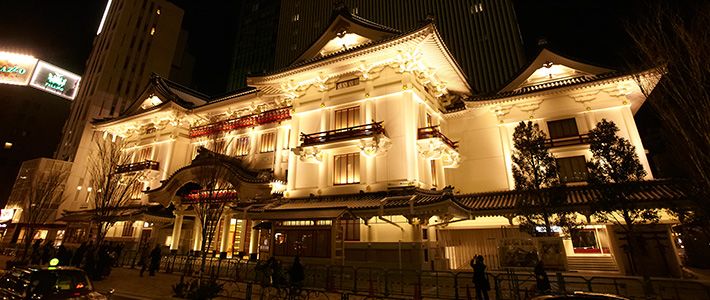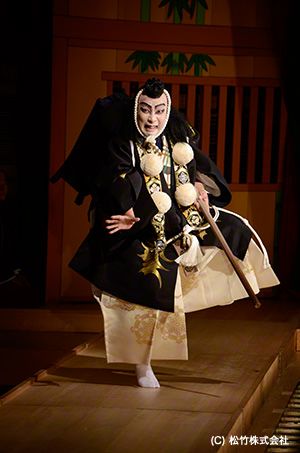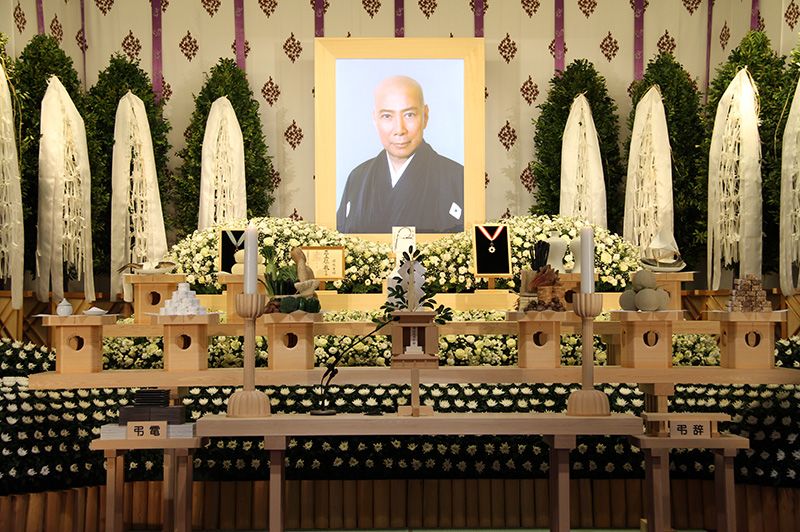
Kabuki Fights for its Future After Two Tragic Losses
Society Culture- English
- 日本語
- 简体字
- 繁體字
- Français
- Español
- العربية
- Русский
The great kabuki actor Ichikawa Danjūrō died unexpectedly on February 3, 2013, at the age of 66—just two months before the opening of the rebuilt Kabukiza, the premier venue for kabuki in Tokyo. Danjūrō was suddenly hospitalized in December, around the time he was appeared in the kao-mise (“face-showing”) ceremony—a yearly all-star event where kabuki’s biggest names appear on stage at Kyoto’s main theater, Minamiza. Although there had been concerns about his health, the death came as a shock to many, who thought he was recuperating in preparation for the first of the so-called kokera otoshi performances to mark the opening of the Kabukiza in April.
Loss of Danjūrō Is a Heavy Blow
 Ichikawa Danjūrō playing Benkei in Kanjinchō (October 2012, Shinbashi Enbujō). Photo courtesy Shōchiku Co., Ltd. May not be reproduced without permission.
Ichikawa Danjūrō playing Benkei in Kanjinchō (October 2012, Shinbashi Enbujō). Photo courtesy Shōchiku Co., Ltd. May not be reproduced without permission.
The actor was the twelfth to use the stage name Ichikawa Danjūrō, and he made it his mission to present audiences with the aragato (“rough business”) style of kabuki pioneered in the seventeenth century by the first Danjūrō. This larger-than-life acting style, characterized by exaggerated movement and speech, formed the basis for the kabuki style prevalent in Edo (present-day Tokyo). Danjūrō had a humanity and an artistic quality that went beyond the level of mere technique, making him a kabuki actor beyond compare. His performances were the true embodiment of the notion that “art comes down to the artist.” It was in this sense that Danjūrō came to be the embodiment of today’s kabuki.
The great kabuki actor’s death has left many people with the feeling that kabuki has lost a pillar of strength. The tragedy is made worse by the fact it comes close on the heels of the loss of another renowned kabuki actor, Nakamura Kanzaburō, who died on December 5, 2012. He was about ten years younger than Danjūrō and known for the guidance he provided to younger kabuki performers. This double-tragedy has raised old concerns about the road ahead for kabuki. For the past 20 years, there have been few worries about the future of kabuki, which has flourished thanks to talented performers who enjoy popularity with the public, but the day is quickly approaching when the next generation will have to play the leading role.
Like Danjūrō, who was in his mid-sixties at the time of his death, many influential kabuki actors today are in their sixties or seventies, such as Onoe Kikugorō, Matsumoto Kōshirō, Nakamura Kichiemon, Kataoka Nizaemon, Nakamura Baigyoku, and Bandō Tamasaburō. Even though they remain physically and mentally robust, and the average lifespan in Japan is now over 80, there is no question that they are of an advanced age. Even kabuki performers who have honed themselves through years of practice are not immune to the aging process; before long they will have to relinquish their places to members of the younger generation. Objectively speaking, the recent death of Danjūrō is the most salient example of how the changing of the kabuki guard is becoming a pressing reality. This tragedy was like the first, great cannonball to strike the kabuki castle.
Can Young Actors Rise to the Occasion?
The problem comes down to whether the younger-generation actors will be able to preserve and build upon the art of kabuki for the sake of its future practitioners. Although kabuki has lost Nakamura Kanzaburō, who was in the generation just below that of Danjūrō and the other greats listed above, there are still well-known performers in their middle years with the ability to lead the next generation. Bandō Mitsugorō (b. 1956) is one such example, but it is true that many of these actors are not yet that well known among the public.
Still, if you stop to consider the situation down the road, and the process necessary for the growth of the art, it becomes clear that there is no room for complacency. There are more than a few talented performers among the younger generation—such as Ichikawa Somegorō and Ichikawa En’nosuke, as well as the somewhat younger actors like Ichikawa Ebizō (the son of Danjūrō, who will take over his stage name), Onoe Kikunosuke, Onoe Shōroku, and others—but none of these actors are yet in a position where they can take over the reins from their fathers.
An opportune moment has arrived, though, to gauge the prowess of these younger actors. In March, just prior to the opening of Kabukiza, four theaters located in Tokyo will hold performances featuring kabuki stars in their twenties and thirties. Also, during year-long kokera otoshi performances to usher in the new Kabukiza, plans are set for three months of performances starring younger actors from July to the end of September—following the three months of plays featuring actors at the pinnacle of the art today, beginning in April. There are also plans for younger actors to play the leading role at performances staged at other theaters.
The question on people’s minds will be how well the younger performers can showcase their talents in these performances and whether they can strike a chord with audiences. These performances in 2013 offer an ideal opportunity to gauge the future for kabuki, and they are likely to be subject to even greater attention in the wake of Danjūrō’s death. If, in the face of this scrutiny, the younger actors are able to display how far they have come so far, and show the talents of the up-and-coming generation, it will go far to placate some of the concerns being voiced about kabuki’s future.
 Ichikawa Danjūrō’s formal funeral was held on February 27, 2013, at Aoyama Sōgisho in Tokyo. 2,500 people attended. On the previous day, Danjūrō was awarded the Order of the Rising Sun, and in 2007, he was honored as Commandeur de L’Ordre des Artes et des Lettres at the time of his performance at the Paris Opera. Both of these awards can be seen decorating the altar. (Photograph by Nippon.com.)
Ichikawa Danjūrō’s formal funeral was held on February 27, 2013, at Aoyama Sōgisho in Tokyo. 2,500 people attended. On the previous day, Danjūrō was awarded the Order of the Rising Sun, and in 2007, he was honored as Commandeur de L’Ordre des Artes et des Lettres at the time of his performance at the Paris Opera. Both of these awards can be seen decorating the altar. (Photograph by Nippon.com.)
A New Kabukiza for a New Generation
The newly built Kabukiza—or technically the “re-opened” theater—is the fifth of the main kabuki theaters to bear that name, dating back to the original that opened in 1889. It replaces the fourth Kabukiza, the much beloved postwar shrine of kabuki, which was reconstructed on separate occasions after burning down due to natural disaster and war.
The fourth Kabukiza was a concrete building that skillfully incorporated traditional elements, resulting in a unique blend of the old and the new. The design was widely embraced by fans of kabuki and many others who viewed it as a Tokyo landmark. That theater was closed down and demolished three years ago, due to dilapidation, and now a new, fifth Kabukiza has been built on the same spot, with a design that is almost the same as the old theater except for some modern features. The lead-up to the theater’s opening evokes a mixture of thoughts touching on the death of Danjūrō, the new venue that replaces the old, and the handing of the baton from one generation to the next in the kabuki world.
Seen from a broader historical perspective, kabuki has a history and tradition stretching back over four centuries. During those long years, the changing of the guard among leading actors has occurred any number of times. Up to the present moment there have been times when the death of a leading actor spurs noisy talk of the crisis of kabuki, but then the younger performers rise to the occasion and carry on the tradition, while creating performances that suit contemporary times. Looking at the period since the end of World War II, around the time the fourth Kabukiza was built in 1951, many of the stars of the prewar period were dying and some people warned that kabuki would collapse. In fact, there was a talented younger generation in the shadows of those greats, and the younger performers rose to prominence and sustained kabuki in the postwar period. Moreover, whereas their fathers had only performed in Japan given the limitations of the time, the younger postwar stars performed overseas, bringing the art to people around the world.
The postwar generation, in turn, had joined the ranks of the elderly by the end of the twentieth century, with their sons taking over from them. The recently deceased Danjūrō and others made up those next-generation stars, who succeeded in building a flourishing kabuki scene from the end of the last century until now. The generation included actors who pioneered unprecedented activities that the previous generation could not have imagined—such as Matsumoto Kōshirō IX, who has performed in musicals along with kabuki; Ichikawa En’nosuke III, who has been active in opera; and Nakamura Kanzaburō XVIII, who created a traveling kabuki troupe that entertained audiences in the United States and Europe.
In these sorts of ways, by holding on to its traditions while at the same time experimenting with new ideas, kabuki has managed to continue to the present, passing from one generation and historical period to the next. And now, once again, the art is at a generational crossroads. If the young and middle-aged actors today can fully develop their abilities and take over from their fathers, the murmuring of concerns about the future of kabuki will no doubt vanish like mist.
(Originally written in Japanese on February 19, 2012. Title Photograph: the new Kabukiza lit up [February 21, 2013, taken by Hanai Tomoko].)